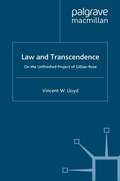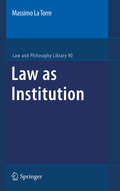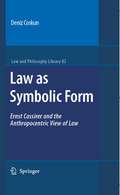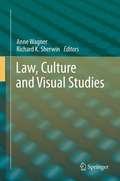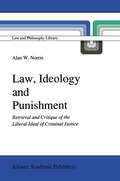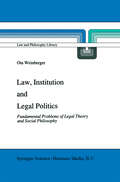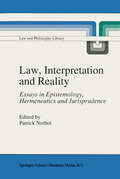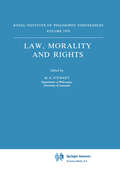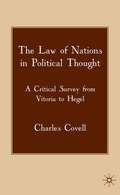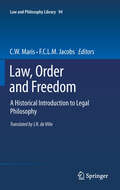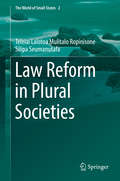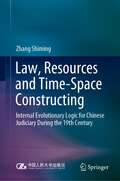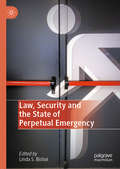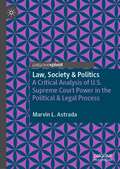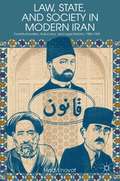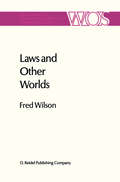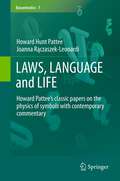- Table View
- List View
Law and Transcendence: On the Unfinished Project of Gillian Rose (Renewing Philosophy)
by V. LloydLaw and Transcendence examines and develops the philosophy of British Philosopher Gillian Rose. By putting Rose's thought into critical dialogue with contemporary philosophers and religious thinkers, the author demonstrates the continuing importance of her work and the importance of critical engagement between philosophy and religious thought .
The Law as a Moral Agent: Making People Good (SpringerBriefs in Law)
by Charles Foster Jonathan HerringThis book examines the controversial and repercussive contention that an objective of the law should be to promote personal morality - to make people ethically better. It surveys a number of domains, including criminal law, tort law, contract law, family law, and medical law (particularly the realm of moral enhancement technologies) asking for each: (a) Does the existing law seek to promote personal morality? (b) If so, what is the account of morality promoted, and what is the substantive content? (c) Does it work? and (d) Is this a legitimate objective?
Law as Institution (Law and Philosophy Library #90)
by Massimo La TorreThis book – which is the result of several years of research, discussion, writing and re-writing – consists of three parts and eight chapters. The rst part is given by the two rst chapters introducing the issue of validity and facticity in law. The second part (Chapters 3, 4 and 5) is the core of this study and tries to present a theory based on a speci c view about language and social practice. The third part deal with the issue of value judgments and views about morality and consists of Chapters 6 and 7. Chapter 8 should nally serve as epilogue. In the rst chapter a discussion is started about the relationship between law and power, seen as a presupposition for an assessment of the nature of law. As a matter of fact, as has been remarked, “general theories of law struggle to do justice to the 1 multiple dualities of the law”. Indeed, law has a “dual nature”: it is a fact, but it also a norm, a sort of ideal entity. Law is sanction, but it is also discourse. It is effectivity, or facticity, but it is also a vehicle of principles among which the central one is justice. But this duality is not only a phenomenological, or a matter of justi cation and implementation as two separate moments.
Law as Passion: Systems Theory and Constitutional Theory in Peripheral Modernity
by Miguel Nogueira de Brito Carina Calabria Fábio Portela L. AlmeidaInspired by the works of Professor Marcelo Neves, in this book colleagues come together to explore how their research has been influenced by non-European and post-colonial approaches. With a foreword by Karl-Heinz Ladeur, it features essays written by leading scholars in the fields of sociology of law and constitutional theory – including Hauke Brunkhorst, Darío Rodrígues, Kimmo Nuotio and Pablo Holmes.The content is divided into four sections, the first of which, “Law, State, and Global Crisis,” covers topics related to the modern constitutional state, the crisis of global capitalism, and the global rule of law. The second, “Symbolic Constitutionalization,” analyzes challenges to constitutionalism in the “Peripheral Modernity.” The authors in the third section examine how the concept of “Transconstitutionalism” can shed new light on contemporary debates concerning global public law. In turn, the last section of the book, “Systems Theory and Public Law,” addresses systems theory issues in the fields of legal history and administrative law.The book presents a relevant and original discussion encompassing such diverse fields as constitutional theory, international law, systems theory, and sociology of constitutions.
Law as Symbolic Form: Ernst Cassirer and the Anthropocentric View of Law (Law and Philosophy Library #82)
by Deniz CoskunThis book describes the rule of law as the reign of persuasion rather than the reign of force, and democracy as the reign by persuasion rather than the reign by force. It synthesizes a vast amount of current Cassirer-literature and makes a contribution to jurisprudence. The book is the first systematic elaboration on law as a symbolic form and it sheds new light on a still dark area of intellectual and jurisprudential thought.
Law, Culture and Visual Studies
by Anne Wagner Richard K. SherwinThe proposed volumes are aimed at a multidisciplinary audience and seek to fill the gap between law, semiotics and visuality providing a comprehensive theoretical and analytical overview of legal visual semiotics. They seek to promote an interdisciplinary debate from law, semiotics and visuality bringing together the cumulative research traditions of these related areas as a prelude to identifying fertile avenues for research going forward.Advance Praise for Law, Culture and Visual Studies This diverse and exhilarating collection of essays explores the many facets both historical and contemporary of visual culture in the law. It opens a window onto the substantive, jurisdictional, disciplinary and methodological diversity of current research. It is a cornucopia of materials that will enliven legal studies for those new to the field as well as for established scholars. It is a ‘must read’ that will leave you wondering about the validity of the long held obsession that reduces the law and legal studies to little more than a preoccupation with the word. Leslie J Moran Professor of Law, Birkbeck College, University of London Law, Culture & Visual Studies is a treasure trove of insights on the entwined roles of legality and visuality. From multiple interdisciplinary perspectives by scholars from around the world, these pieces reflect the fullness and complexities of our visual encounters with law and culture. From pictures to places to postage stamps, from forensics to film to folklore, this anthology is an exciting journey through the fertile field of law and visual culture as well as a testament that the field has come of age. Naomi Mezey, Professor of Law, Georgetown University Law Center, Washington, D.C., USA This highly interdisciplinary reference work brings together diverse fields including cultural studies, communication theory, rhetoric, law and film studies, legal and social history, visual and legal theory, in order to document the various historical, cultural, representational and theoretical links that bind together law and the visual. This book offers a breath-taking range of resources from both well-established and newer scholars who together cover the field of law’s representation in, interrogation of, and dialogue with forms of visual rhetoric, practice, and discourse. Taken together this scholarship presents state of the art research into an important and developing dimension of contemporary legal and cultural inquiry. Above all, Law Culture and Visual Studies lays the groundwork for rethinking the nature of law in our densely visual culture: How are legal meanings produced, encoded, distributed, and decoded? What critical and hermeneutic skills, new or old, familiar or unfamiliar, will be needed? Topical, diverse, and enlivening, Law Culture and Visual Studies is a vital research tool and an urgent invitation to further critical thinking in the areas so well laid out in this collection. Desmond Manderson, Future Fellow, ANU College of Law / Research School of Humanities & the Arts, Australian National University, Australia
Law, Ideology and Punishment: Retrieval and Critique of the Liberal Ideal of Criminal Justice (Law and Philosophy Library #12)
by A.W. NorrieThis book is about 'Kantianism' in both a narrow and a broad sense. In the former, it is about the tracing of the development of the retributive philosophy of punishment into and beyond its classical phase in the work of a number of philosophers, one of the most prominent of whom is Kant. In the latter, it is an exploration of the many instantiations of the 'Kantian' ideas of individual guilt, responsibility and justice within the substantive criminal law . On their face, such discussions may owe more or less explicitly to Kant, but, in their basic intellectual structure, they share a recognisably common commitment to certain ideas emerging from the liberal Enlightenment and embodied within a theory of criminal justice and punishment which is in this broader sense 'Kantian'. The work has its roots in the emergence in the 1970s and early 1980s in the United States and Britain of the 'justice model' of penal reform, a development that was as interesting in terms of the sociology of philosophical knowledge as it was in its own right. Only a few years earlier, I had been taught in undergraduate criminology (which appeared at the time to be the only discipline to have anything interesting to say about crime and punishment) that 'classical criminology' (that is, Beccaria and the other Enlightenment reformers, who had been colonised as a 'school' within criminology) had died a major death in the 19th century, from which there was no hope of resuscitation.
The Law in Philosophical Perspectives: My Philosophy of Law (Law and Philosophy Library #41)
by Luc J. WintgensIn this age of collections that is ours, many volumes of collections are published. They contain contributions of several well-known authors, and their aim is to present a selective overview of a relevant field of study. This book has the same purpose. Its aim is to introduce students, scholars and all those interested in current problems of legal theory and legal philosophy to the work of the leading scholars in this field. The large number of publications, both books and articles, that have been produced over recent decades makes it quite difficult, however, for those who are making their first steps in this domain to find firm guidelines. The book is new in its genre because of its method. The choice was made not to reprint an example of contributors' earlier basic articles or a part of one of their books. This would only give a partial view of the rich texture of their work. Rather, the authors were asked to make an original synthesis of their own contributions to the field of legal theory and legal philosophy. Brought together in this volume, they constitute a truly author-ised view of their work. This book is also new in that each essay is complemented with bibliographical information in order to encourage further research on the author's self-selected work. This will help the reader rapidly to become familiar with the whole of the published work of the contributors.
Law, Institution and Legal Politics: Fundamental Problems of Legal Theory and Social Philosophy (Law and Philosophy Library #14)
by Ota WeinbergerIt gives me great pleasure to offer this foreword to the present work of my admired friend and respected colleague Ota Weinberger. Apart from the essays of his which were published in our joint work An Institutional Theory of Law: New Approaches to Legal Positivism in 1986, relatively little of Wein berger's work is available in English. This is the more to be regretted, since his is work of particular interest to jurists of the English-speaking world both in view of its origins and in respect of its content As to its origins, Weinberger war reared as a student of the Pure Theory of Law, a theory which in its Kelsenian form has aroused very great interest and has had considerable influence among anglophoone scholars -perhaps even more than in the Germanic countries. Less well known is the fact that the Pure Theory itself divided into two schools, that of Vienna and that of Brno. It was in the Brno school of Frantisek Weyr that Weinberger's legal theory found its early formation, and perhaps from that early influence one can trace his continuing insistence on the dual character of legal norms -both as genuinely normative and yet at the same time having real social existence.
Law, Interpretation and Reality: Essays in Epistemology, Hermeneutics and Jurisprudence (Law and Philosophy Library #11)
by PatrickNerhotPATRICKNERHOT Since the two operations overlap each other so much, speaking about fact and interpretation in legal science separately would undoubtedly be highly artificial. To speak about fact in law already brings in the operation we call interpretation. EquaHy, to speak about interpretation is to deal with the method of identifying reality and therefore, in large part, to enter the area of the question of fact. By way of example, Bemard Jackson's text, which we have placed in section 11 of the first part of this volume, could no doubt just as weH have found a horne in section I. This work is aimed at analyzing this interpretation of the operation of identifying fact on the one hand and identifying the meaning of a text on the other. All philosophies of law recognize themselves in the analysis they propose for this interpretation, and we too shall seek in this volume to fumish a few elements of use for this analysis. We wish however to make it clear that our endeavour is addressed not only to legal philosophers: the nature of the interpretive act in legal science is a matter of interest to the legal practitioner too. He will find in these pages, we believe, elements that will serve hirn in rcflcction on his daily work.
Law, Language and Translation: From Concepts to Conflicts (SpringerBriefs in Law)
by Rosanna Masiola Renato TomeiThis book is a survey of how law, language and translation overlap with concepts, crimes and conflicts. It is a transdisciplinary survey exploring the dynamics of colonialism and the globalization of crime. Concepts and conflicts are used here to mean ‘conflicting interpretations’ engendering real conflicts. Beginning with theoretical issues and hermeneutics in chapter 2, the study moves on to definitions and applications in chapter 3, introducing cattle stealing as a comparative theme and global case study in chapter 4. Cattle stealing is also known in English as ‘rustling, duffing, raiding, stock theft, lifting and predatorial larceny.’ Crime and punishment are differently perceived depending on cultures and legal systems: ‘Captain Starlight’ was a legendary ‘duffer’; in India ‘lifting’ a sacred cow is a sacrilegious act. Following the globalization of crime, chapter 5 deals with human rights, ethnic cleansing and genocide. International treaties in translation set the scene for two world wars. Introducing ‘unequal treaties’ (e.g. Hong Kong), chapter 6 highlights disasters caused by treaties in translation. Cases feature American Indians (the ‘trail of broken treaties’), Maoris (Treaty of Waitangi) and East Africa (Treaty of Wuchale).
Law, Liberty, and the Rule of Law (Ius Gentium: Comparative Perspectives on Law and Justice #18)
by Imer B. Flores and Kenneth Einar HimmaIn recent years, there has been a substantial increase in concern for the rule of law. Not only have there been a multitude of articles and books on the essence, nature, scope and limitation of the law, but citizens, elected officials, law enforcement officers and the judiciary have all been actively engaged in this debate. Thus, the concept of the rule of law is as multifaceted and contested as it’s ever been, and this book explores the essence of that concept, including its core principles, its rules, and the necessity of defining, or even redefining, the basic concept.Law, Liberty, and the Rule of Law offers timely and unique insights on numerous themes relevant to the rule of law. It discusses in detail the proper scope and limitations of adjudication and legislation, including the challenges not only of limiting legislative and executive power via judicial review but also of restraining active judicial lawmaking while simultaneously guaranteeing an independent judiciary interested in maintaining a balance of power. It also addresses the relationship not only between the rule of law, human rights and separation of powers but also the rule of law, constitutionalism and democracy.
Law, Morality and Rights (Synthese Library #162)
by M. A. StewartThe Royal Institute of Philosophy has been sponsoring conferences in alternate years since 1969. These have from the start been intended to be of interest to persons who are not philosophers by profession. They have mainly focused on interdisciplinary areas such as the philosophies of psychology, education and the social sciences. The volumes arising from these conferences have in cluded discussions between philosophers and distinguished prac titioners of other disciplines relevant to the chosen topic. Beginning with the 1979 conference on 'Law, Morality and Rights' and the 1981 conference on 'Space, Time and Causality' these volumes are now constituted as a series. It is hoped that this series will contribute to advancing philosophical understanding at the frontiers of philosophy and areas of interest to non-philos ophers. It is hoped that it will do so by writing which reduces technicalities as much as the subject-matter permits. In this way the series is intended to demonstrate that philosophy can be clear and worthwhile in itself and at the same time relevant to the interests of lay people.
Law, Narrative and Reality: An Essay in Intercepting Politics (Law and Philosophy Library #30)
by G.C. van RoermundThe Law of Nations in Political Thought: A Critical Survey from Vitoria to Hegel
by C. CovellCharles Covell examines the law of nations encountered in the work of major political thinkers from Vitoria to Hegel. He explains how these thinkers contributed to the current theories of natural law and just war and how they played a key role in the elaboration of the principles which are central to the modern system of the law of nations.
Law, Order and Freedom: A Historical Introduction to Legal Philosophy (Law and Philosophy Library #94)
by C.W. Maris and F.C.L.M. JacobsThe central question in legal philosophy is the relationship between law and morality. The legal systems of many countries around the world have been influenced by the principles of the Enlightenment: freedom, equality and fraternity. The position is similar in relation to the accompanying state ideal of the democratic constitutional state as well as the notion of a welfare state. The foundation of these principles lies in the ideal of individual autonomy. The law must in this view guarantee a social order which secures the equal freedom of all. This freedom is moreover fundamental because in modern pluralistic societies a great diversity of views exist concerning the appropriate way of life. This freedom ideal is however also strongly contested. In Law, Order and Freedom, a historical overview is given pertaining to the question of the extent to which the modern Enlightenment values can serve as the universal foundation of law and society.
Law, Power and Culture: Supporting Change From Within (Palgrave Socio-Legal Studies)
by F. KnightA fresh theory on how individuals respond to inequalities occurring within their own communities. This original and insightful study draws on empirical research on the Santal people of Asia, examining power relations within social fields, and the state, to reveal a typology of power practices, and applies these to forced marriage in the West.
Law Reform in Plural Societies (The World of Small States #2)
by Teleiai Lalotoa Mulitalo Ropinisone Silipa SeumanutafaThis book asserts that the Pacific Islands continue to struggle with the colonial legacy of plural legal systems, comprising laws and legal institutions from both the common law and the customary legal system. It also investigates the extent to which customary principles and values are accommodated in legislation. Focusing on Samoa, the author argues that South Pacific countries continue to adopt a Western approach to law reform without considering legal pluralism, which often results in laws which are unsuitable and irrelevant to Samoa. In the context of this system of law making, effective law reform in Samoa can only be achieved where the law reform process recognises the legitimacy of the two primary legal systems. The book goes on to present a law reform process that is more relevant and suitable for law making in the Pacific Islands or any post-colonial societies.
Law, Resources and Time-Space Constructing: Internal Evolutionary Logic for Chinese Judiciary During the 19th Century
by Zhang ShimingThis book studies the judicial evolution of the Qing Dynasty. It sums up the changes from six major aspects: 1. Banfang(班房)emerged in the late Qianlong period; 2. The opening of capital appeals(京控)early in Jiaqing’s reign; 3. The consular jurisdiction was established during Daoguang’s reign; 4. The execution on the spot (就地正法)was started in Daoguang and Xianfeng periods; 5. The introduction of fashenju (发审局,a interrogatory court) happened during Tongzhi’s reign; 6. Late in Guangxu’s reign, banishment was abolished, and reforms were made for prisons. In the past, people did not have a comprehensive understanding of these big changes. From the perspective of legal culture, scholars often criticize traditional Chinese law focuses on criminal law while ignores civil law in terms of legal culture, but this situation can be explained in part by the inadequate allocation of resources and authoritarian resources in traditional societies. Using a large number of archives and precious materials such as private notes that were not noticed by academics in the past, this book adopts the research path of new historical jurisprudence to explore the inner logic of judicial evolution in the Qing Dynasty, focusing on the triangular connection between legal rules, resources, and temporal and spatial constructions, which is an important contribution to the study of traditional Chinese law.
Law, Security and the State of Perpetual Emergency
by Linda S. BishaiPresenting diverse contributors from legal, academic, and practitioner sectors, this book illustrates how the distinctions between international and domestic law are falling away in the context of security, particularly in the responses to terrorism, and explores the implications of these dramatic shifts in the normative order. Fundamental changes in the powers of the state and the rights of populations have accelerated since the globalized response to 9/11, creating effects that spread beyond borders and operate in a new, as yet under-conceptualized space. Although these altered practices were said to be in response to exceptional circumstances — a response to terrorism — they have become increasingly established in an altered baseline norm. This book explores the (inter)national implications of exceptional legal efforts to protect states’ domestic space in the realm of security.
Law, Society & Politics: A Critical Analysis of U.S. Supreme Court Power in the Political & Legal Process
by Marvin L. AstradaThis book explores critical questions pertaining to the character and content of the “American People” as posited in the US Supreme Court’s interpretation of the fundamental law. What exactly is an American? Who or what comprise the People? What are the constitutive sociocultural, political, and economic ordering principles of the American People and society? How does the Court impact the nationalist character and content of law and policy? From a sociocultural, economic, political, and ideological perspective, the Court’s singular proclamations as to what the US Constitution means, what is its purpose, and how it is to be perceived and implemented have profound consequences for representational politics and notions of what exactly constitutes the American polity. This book employs a critical, conceptual, and structural approach, critically examining the notion of the People in constitutional discourse, and its impact on government, politics, law, and society in the present.
Law, State, and Society in Modern Iran: Constitutionalism, Autocracy, and Legal Reform, 1906–1941
by H. EnayatUsing a 'Historical Institutionalist' approach, this book sheds light on a relatively understudied dimension of state-building in early twentieth century Iran, namely the quest for judicial reform and the rule of law from the 1906 Constitutional Revolution to the end of Reza Shah's rule in 1941.
Law, Truth, and Reason: A Treatise on Legal Argumentation (Law and Philosophy Library #97)
by Raimo SiltalaThis book is an innovative contribution to analytical jurisprudence. It is mainly based on the distinct premises of linguistic philosophy and Carnapian semantics, but also addresses the issues of institutional philosophy, social pragmatism, and legal principles as envisioned by Dworkin, among others. Wróblewski´s three ideologies (bound/free/legal and rational) and Makkonen´s three situations (isomorphic/semantically vague/normative gap) of judicial decision-making are further developed by means of 10 frames of legal analysis as discerned by the author. With the philosophical theories of truth serving as a reference, the frames of legal analysis include the isomorphic theory of law (Wittgenstein, Makkonen), the coherence theory of law (Alexy, Peczenik, Dworkin), the new rhetoric and legal argumentation theory (Perelman, Aarnio), social consequentialism (Posner), natural law theory (Fuller, Finnis), and the sequential model of legal reasoning by Neil MacCormick and the Bielefelder Kreis. At the end, some key issues of legal metaphysics are addressed, like the notion of legal systematics and the future potential of the analytical approach in jurisprudence.
Laws and other Worlds: A Humean Account of Laws and Counterfactuals (The Western Ontario Series in Philosophy of Science #31)
by Fred WilsonLAWS, LANGUAGE and LIFE: Howard Pattee’s classic papers on the physics of symbols with contemporary commentary (Biosemiotics #7)
by Howard Hunt Pattee Joanna Rączaszek-LeonardiHoward Pattee is a physicist who for many years has taken his own path in studying the physics of symbols, which is now a foundation for biosemiotics. By extending von Neumann’s logical requirements for self-replication, to the physical requirements of symbolic instruction at the molecular level, he concludes that a form of quantum measurement is necessary for life. He explains why all non-dynamic symbolic and informational controls act as special (allosteric) constraints on dynamical systems. Pattee also points out that symbols do not exist in isolation but in coordinated symbol systems we call languages. Such insights turn out to be necessary to situate biosemiotics as an objective scientific endeavor. By proposing a way to relate quiescent symbolic constraints to dynamics, Pattee’s work builds a bridge between physical, biological, and psychological models that are based on dynamical systems theory. Pattee’s work awakes new interest in cognitive scientists, where his recognition of the necessary separation—the epistemic cut—between the subject and object provides a basis for a complementary third way of relating the purely symbolic, computational models of cognition and the purely dynamic, non-representational models. This selection of Pattee’s papers also addresses several other fields, including hierarchy theory, artificial life, self-organization, complexity theory, and the complementary epistemologies of the physical and biological sciences.
